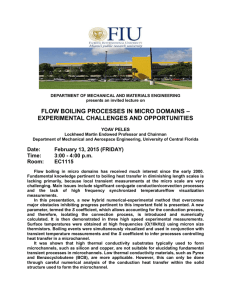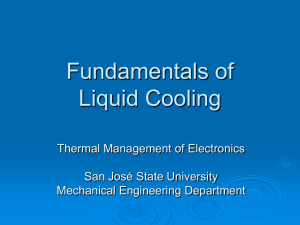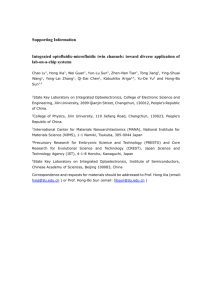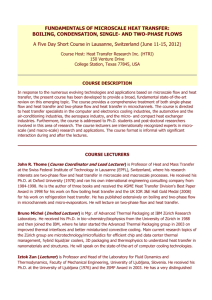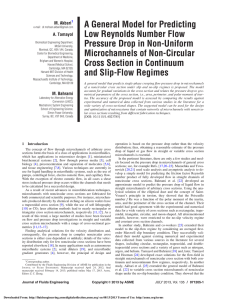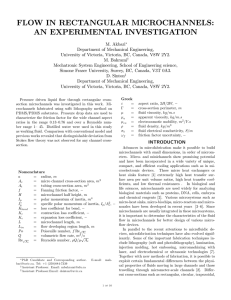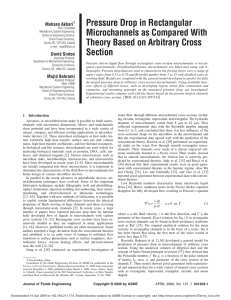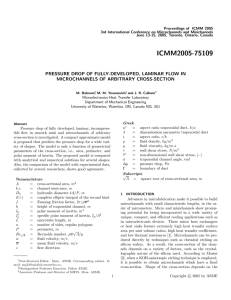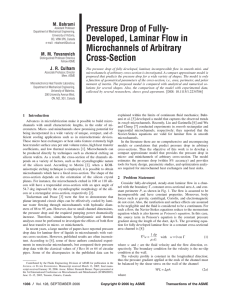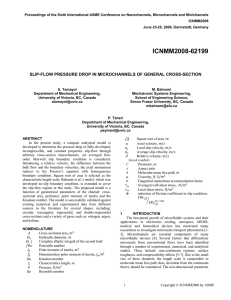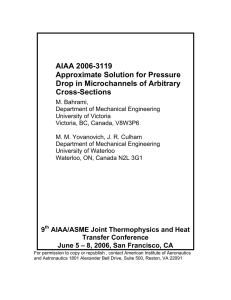Proceedings of ICNMM 2008
advertisement
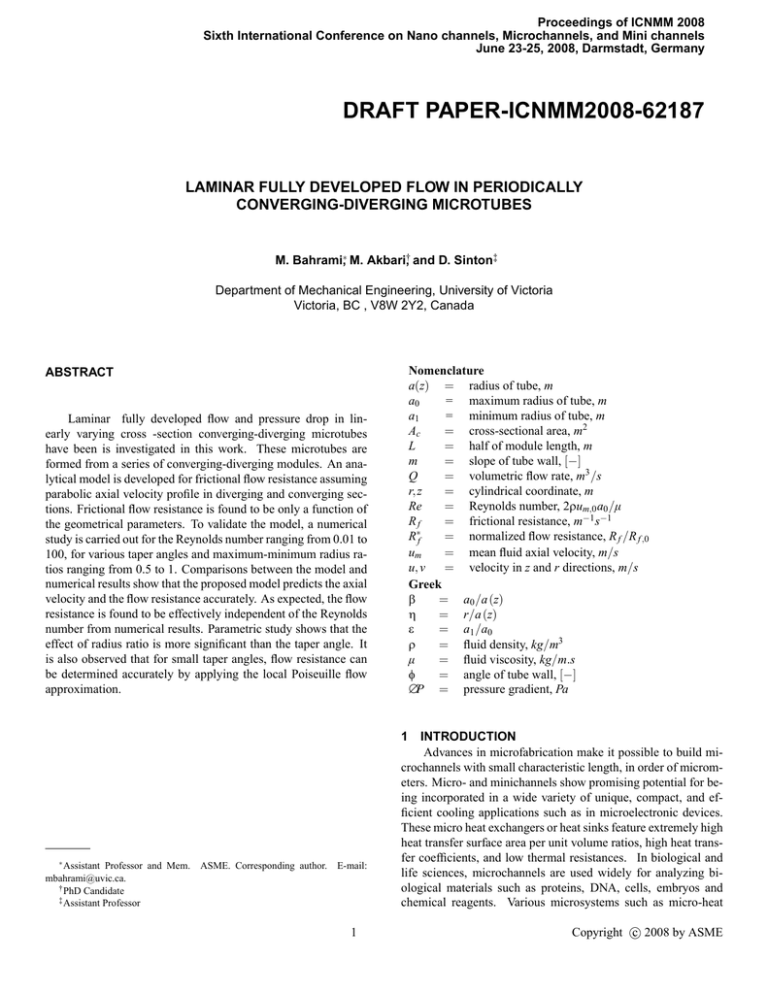
Proceedings of ICNMM 2008 Sixth International Conference on Nano channels, Microchannels, and Mini channels June 23-25, 2008, Darmstadt, Germany DRAFT PAPER-ICNMM2008-62187 LAMINAR FULLY DEVELOPED FLOW IN PERIODICALLY CONVERGING-DIVERGING MICROTUBES M. Bahrami, M. Akbari†, and D. Sinton‡ Department of Mechanical Engineering, University of Victoria Victoria, BC , V8W 2Y2, Canada Nomenclature a(z) = radius of tube, m a0 = maximum radius of tube, m a1 = minimum radius of tube, m Ac = cross-sectional area, m2 L = half of module length, m m = slope of tube wall, [ ] Q = volumetric ow rate, m3 =s r; z = cylindrical coordinate, m Re = Reynolds number, 2ρum;0 a0 =µ Rf = frictional resistance, m 1 s 1 Rf = normalized ow resistance, R f =R f ;0 um = mean uid axial velocity, m=s u; v = velocity in z and r directions, m=s Greek β = a0 =a (z) η = r=a (z) ε = a1 =a0 ρ = uid density, kg=m3 µ = uid viscosity, kg=m:s φ = angle of tube wall, [ ] ∆P = pressure gradient, Pa ABSTRACT Laminar fully developed ow and pressure drop in linearly varying cross -section converging-diverging microtubes have been is investigated in this work. These microtubes are formed from a series of converging-diverging modules. An analytical model is developed for frictional ow resistance assuming parabolic axial velocity pro le in diverging and converging sections. Frictional ow resistance is found to be only a function of the geometrical parameters. To validate the model, a numerical study is carried out for the Reynolds number ranging from 0.01 to 100, for various taper angles and maximum-minimum radius ratios ranging from 0.5 to 1. Comparisons between the model and numerical results show that the proposed model predicts the axial velocity and the ow resistance accurately. As expected, the ow resistance is found to be effectively independent of the Reynolds number from numerical results. Parametric study shows that the effect of radius ratio is more signi cant than the taper angle. It is also observed that for small taper angles, ow resistance can be determined accurately by applying the local Poiseuille ow approximation. 1 Assistant Professor and Mem. mbahrami@uvic.ca. † PhD Candidate ‡ Assistant Professor ASME. Corresponding author. E-mail: 1 INTRODUCTION Advances in microfabrication make it possible to build microchannels with small characteristic length, in order of micrometers. Micro- and minichannels show promising potential for being incorporated in a wide variety of unique, compact, and efcient cooling applications such as in microelectronic devices. These micro heat exchangers or heat sinks feature extremely high heat transfer surface area per unit volume ratios, high heat transfer coef cients, and low thermal resistances. In biological and life sciences, microchannels are used widely for analyzing biological materials such as proteins, DNA, cells, embryos and chemical reagents. Various microsystems such as micro-heat Copyright c 2008 by ASME sinks, micro-biochips, micro-reactors and micro-nozzles have been developed in recent years. Since microchannels are usually integrated in these microsystems, it is important to know the characteristics of the uid ow in these microchannels for better design of various micro- ow devices. Microchannels are normally produced by either precision machining or chemical etching or recently soft lithography in PDMS. Together with new methods of fabrication, it is possible to expliot certain fundamental differences between the physical properties of uids moving in large channels and those travelling through micrometre-scale channels [Whiteside]. Using these methods, the channel cross-section would be normally rectangular. Aslo since microchannels length is normally long, the main part of the ow is fully developed. In recent years, a large number of papers have reported pressure drop data for laminar fully developed ow of liquids in microchannels with various cross-sections. However, published results are often inconsistent. Peng and Peterson et al. [Xu references] experimentally studied friction ow and heat transfer characteristics of water ow through microchannels with hydraulic diameters ranging from 130 µm to 340 µm. They used precision machining on stainless steel substrate method. Their experimental results for ow friction showed that signi cant deviation from the characteristics of the macro-size channel ow were observed. Their results indicated that unstabilities in the ow started at the Reynolds number of 200 to 700. Mala and Li [9 of Xu ] experimentally investigated the water ow in circular cross-section microchannels with diameters ranging from 50 to 254 µm. Their experimental results were presented at the Reynolds number ranging from 100 to 2000. They showed that their results were signi cantly deviated from the predictions of the conventional theory for microtubes with diameter smaller than 150 µm. their experimental results were larger than those predicted by the conventional theory. They interpreted their anomalous phenomena as either an early transition from laminar ow to turbulent ow or due to surface roughness effects. Pfahler et al. [2, 3 Xu] presented experimental investigations of the uid ow in microchannels. In their study, nitrogen and helium gases, isopropyl liquid and silicone oil, were used. The microchannels were fabricated on silicon wafer by an etching method. Different phenomena for different uids were observed. They found that in channels with relatively large cross-sections, the uid roughly behaved in accordance with the Navier-Stokes predictions, and as the channel depth decreased, there appeared to be a critical channel size where the general behavior of the experimental observations deviates from the predictions. - Literature review (Experimental) - Pressure measrument issues: like size, inlet and outlet effects, uncertainty. Table 1. INPUT PARAMETERS FOR TWO TYPICAL MICROTUBES. Parameter Value a0 500 µm Re 10 Case1 φ=7 0:5 < ε < 1 Case2 2 < φ < 15 ε = 0:8 3 EXPERIMENTAL - Microchannel fabrication: Table of sizes - Experimental set up: gure - Microchannels cross section picture (Kandlikar can help) - Experimental data analysis (relationsships for f and ...) -uncertainty (kandlikar) 4 RESULTS AND DISCUSSION 5 SUMMARY AND CONCLUSIONS ACKNOWLEDGMENT [The authors gratefully acknowledge the nancial support of the the Natural Sciences and Engineering Research Council of Canada, NSERC.] 2 THEORETICAL MODELING - Literature review -Bahrami's Model: Assumptions, saint veron concept, we are going to compar our results with that. 2 Copyright c 2008 by ASME
